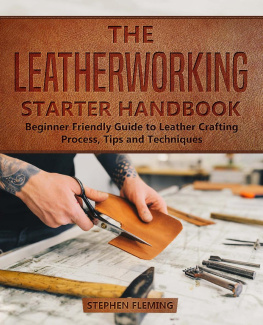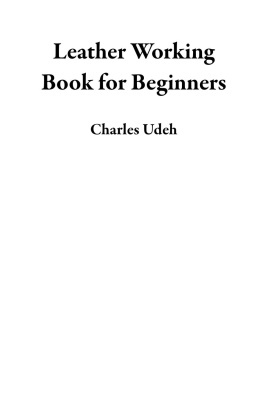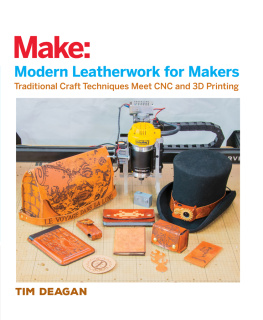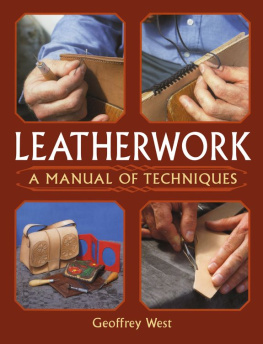Rines - Leather Crafting Beginner’s Manual: A Step-by-Step Illustrated Guide with Basic Leatherworking Projects and Techniques
Here you can read online Rines - Leather Crafting Beginner’s Manual: A Step-by-Step Illustrated Guide with Basic Leatherworking Projects and Techniques full text of the book (entire story) in english for free. Download pdf and epub, get meaning, cover and reviews about this ebook. year: 2020, genre: Home and family. Description of the work, (preface) as well as reviews are available. Best literature library LitArk.com created for fans of good reading and offers a wide selection of genres:
Romance novel
Science fiction
Adventure
Detective
Science
History
Home and family
Prose
Art
Politics
Computer
Non-fiction
Religion
Business
Children
Humor
Choose a favorite category and find really read worthwhile books. Enjoy immersion in the world of imagination, feel the emotions of the characters or learn something new for yourself, make an fascinating discovery.

- Book:Leather Crafting Beginner’s Manual: A Step-by-Step Illustrated Guide with Basic Leatherworking Projects and Techniques
- Author:
- Genre:
- Year:2020
- Rating:3 / 5
- Favourites:Add to favourites
- Your mark:
- 60
- 1
- 2
- 3
- 4
- 5
Leather Crafting Beginner’s Manual: A Step-by-Step Illustrated Guide with Basic Leatherworking Projects and Techniques: summary, description and annotation
We offer to read an annotation, description, summary or preface (depends on what the author of the book "Leather Crafting Beginner’s Manual: A Step-by-Step Illustrated Guide with Basic Leatherworking Projects and Techniques" wrote himself). If you haven't found the necessary information about the book — write in the comments, we will try to find it.
Rines: author's other books
Who wrote Leather Crafting Beginner’s Manual: A Step-by-Step Illustrated Guide with Basic Leatherworking Projects and Techniques? Find out the surname, the name of the author of the book and a list of all author's works by series.
Leather Crafting Beginner’s Manual: A Step-by-Step Illustrated Guide with Basic Leatherworking Projects and Techniques — read online for free the complete book (whole text) full work
Below is the text of the book, divided by pages. System saving the place of the last page read, allows you to conveniently read the book "Leather Crafting Beginner’s Manual: A Step-by-Step Illustrated Guide with Basic Leatherworking Projects and Techniques" online for free, without having to search again every time where you left off. Put a bookmark, and you can go to the page where you finished reading at any time.
Font size:
Interval:
Bookmark:
This book could not have been written without the guidance and generosity of everyone I have come in contact with one way or another. Your influences are all over this book. Thank you.
This book is dedicated to everyone seeking knowledge out there.
document may be reproduced or transmitted in any form or by any means, electronic or mechanical, including photocopying, recording, or by any information storage and retrieval system without permission in writing from the author. The unauthorized reproduction or distribution of this unique work is illegal.
All the information contained in this book is purely for educational activities only. The writer does not assert the accuracy or wholesomeness of any info gotten from this book. The views contained within the pages of this material are those of the author in its
entirety. The author/writer will not be held accountable or liable for any missing information, omissions or errors, damages, injuries, or any losses that may occur from the use of information gotten from this book.

Font size:
Interval:
Bookmark:
Similar books «Leather Crafting Beginner’s Manual: A Step-by-Step Illustrated Guide with Basic Leatherworking Projects and Techniques»
Look at similar books to Leather Crafting Beginner’s Manual: A Step-by-Step Illustrated Guide with Basic Leatherworking Projects and Techniques. We have selected literature similar in name and meaning in the hope of providing readers with more options to find new, interesting, not yet read works.
Discussion, reviews of the book Leather Crafting Beginner’s Manual: A Step-by-Step Illustrated Guide with Basic Leatherworking Projects and Techniques and just readers' own opinions. Leave your comments, write what you think about the work, its meaning or the main characters. Specify what exactly you liked and what you didn't like, and why you think so.





